Taxation Law Report: Taxation Advice for Olivia Patterson - 2019
VerifiedAdded on 2022/11/11
|11
|2274
|162
Report
AI Summary
This report provides a comprehensive analysis of Olivia Patterson's tax situation, addressing various aspects of Australian taxation law. It begins with a letter of advice outlining the scope of the advice, relevant facts, and a summary of the recommendations. The report delves into the tax implications of Olivia's employment income, including salary, superannuation contributions, and fringe benefits like discounts and reimbursements for work-related expenses. It examines the tax treatment of her property investments, including deductions for expenses related to her Inverloch property and the non-deductibility of certain expenses related to the Phillip Island property. The report further analyzes the tax implications of her interest-bearing accounts and the transfer of shares, providing guidance on income declaration and capital gains tax. The report concludes with a summary of the advice and references to relevant legislation and case law, offering a thorough understanding of Olivia's tax obligations and potential strategies for tax optimization.
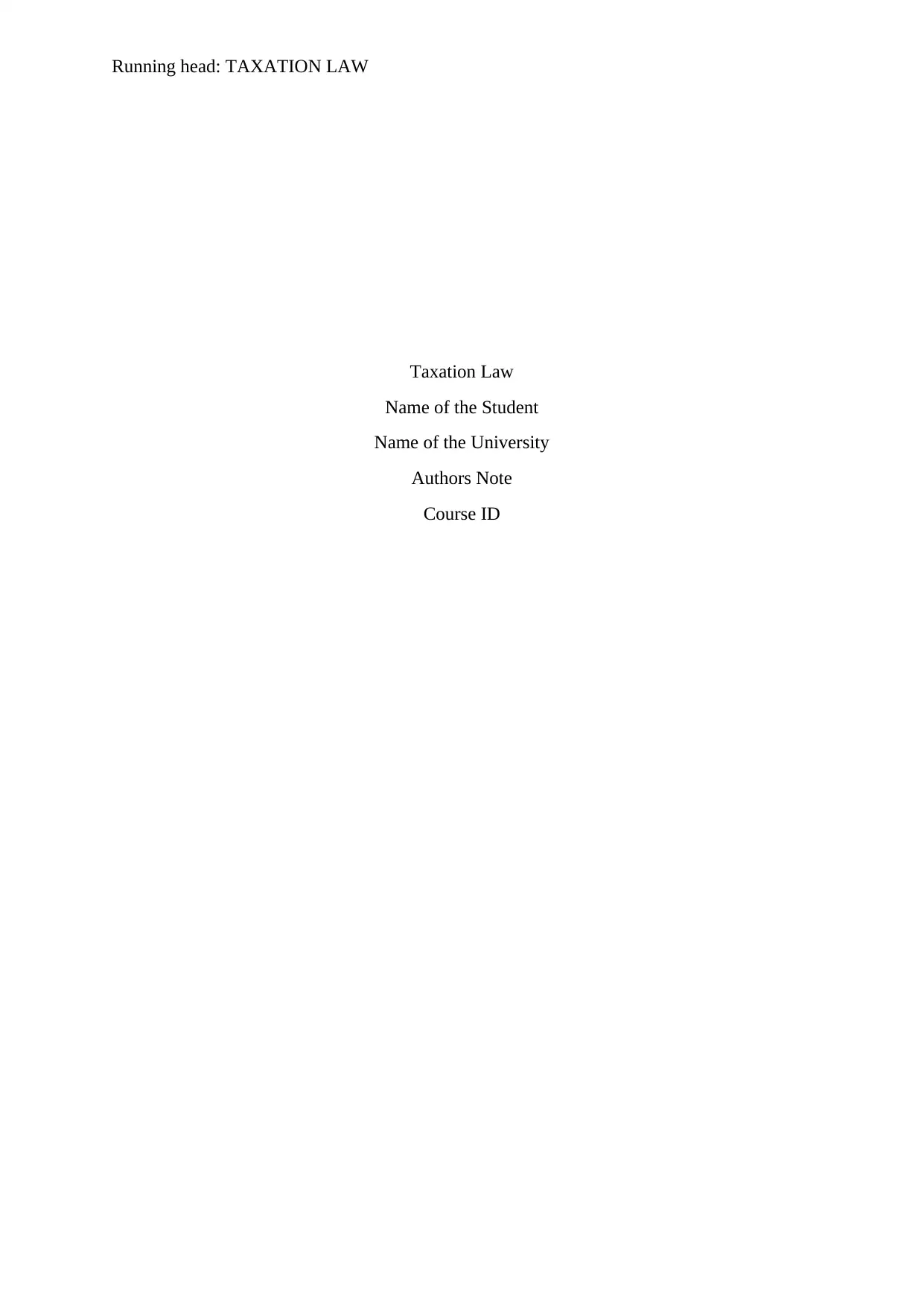
Running head: TAXATION LAW
Taxation Law
Name of the Student
Name of the University
Authors Note
Course ID
Taxation Law
Name of the Student
Name of the University
Authors Note
Course ID
Paraphrase This Document
Need a fresh take? Get an instant paraphrase of this document with our AI Paraphraser
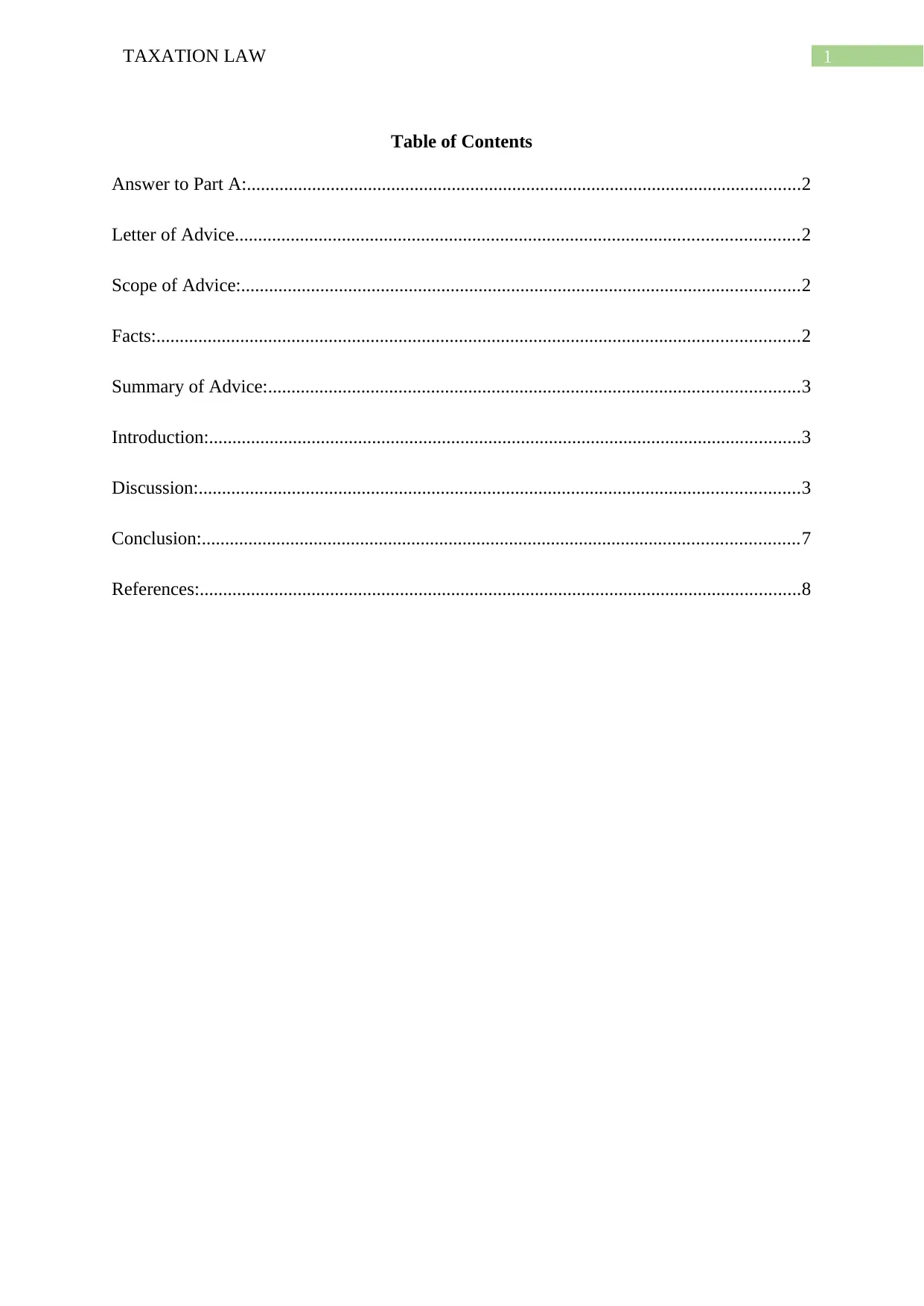
1TAXATION LAW
Table of Contents
Answer to Part A:.......................................................................................................................2
Letter of Advice.........................................................................................................................2
Scope of Advice:........................................................................................................................2
Facts:..........................................................................................................................................2
Summary of Advice:..................................................................................................................3
Introduction:...............................................................................................................................3
Discussion:.................................................................................................................................3
Conclusion:................................................................................................................................7
References:.................................................................................................................................8
Table of Contents
Answer to Part A:.......................................................................................................................2
Letter of Advice.........................................................................................................................2
Scope of Advice:........................................................................................................................2
Facts:..........................................................................................................................................2
Summary of Advice:..................................................................................................................3
Introduction:...............................................................................................................................3
Discussion:.................................................................................................................................3
Conclusion:................................................................................................................................7
References:.................................................................................................................................8
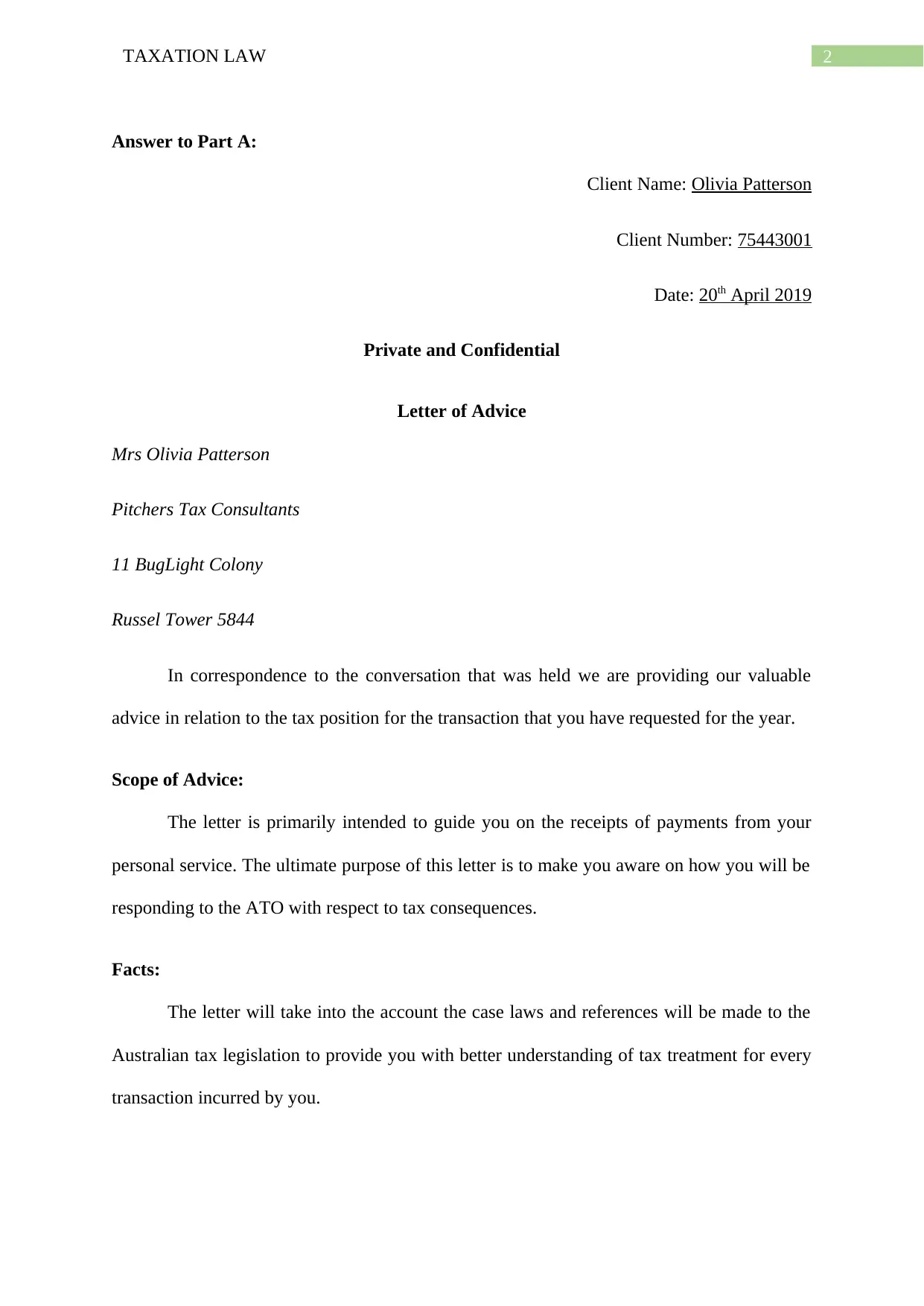
2TAXATION LAW
Answer to Part A:
Client Name: Olivia Patterson
Client Number: 75443001
Date: 20th April 2019
Private and Confidential
Letter of Advice
Mrs Olivia Patterson
Pitchers Tax Consultants
11 BugLight Colony
Russel Tower 5844
In correspondence to the conversation that was held we are providing our valuable
advice in relation to the tax position for the transaction that you have requested for the year.
Scope of Advice:
The letter is primarily intended to guide you on the receipts of payments from your
personal service. The ultimate purpose of this letter is to make you aware on how you will be
responding to the ATO with respect to tax consequences.
Facts:
The letter will take into the account the case laws and references will be made to the
Australian tax legislation to provide you with better understanding of tax treatment for every
transaction incurred by you.
Answer to Part A:
Client Name: Olivia Patterson
Client Number: 75443001
Date: 20th April 2019
Private and Confidential
Letter of Advice
Mrs Olivia Patterson
Pitchers Tax Consultants
11 BugLight Colony
Russel Tower 5844
In correspondence to the conversation that was held we are providing our valuable
advice in relation to the tax position for the transaction that you have requested for the year.
Scope of Advice:
The letter is primarily intended to guide you on the receipts of payments from your
personal service. The ultimate purpose of this letter is to make you aware on how you will be
responding to the ATO with respect to tax consequences.
Facts:
The letter will take into the account the case laws and references will be made to the
Australian tax legislation to provide you with better understanding of tax treatment for every
transaction incurred by you.
⊘ This is a preview!⊘
Do you want full access?
Subscribe today to unlock all pages.

Trusted by 1+ million students worldwide
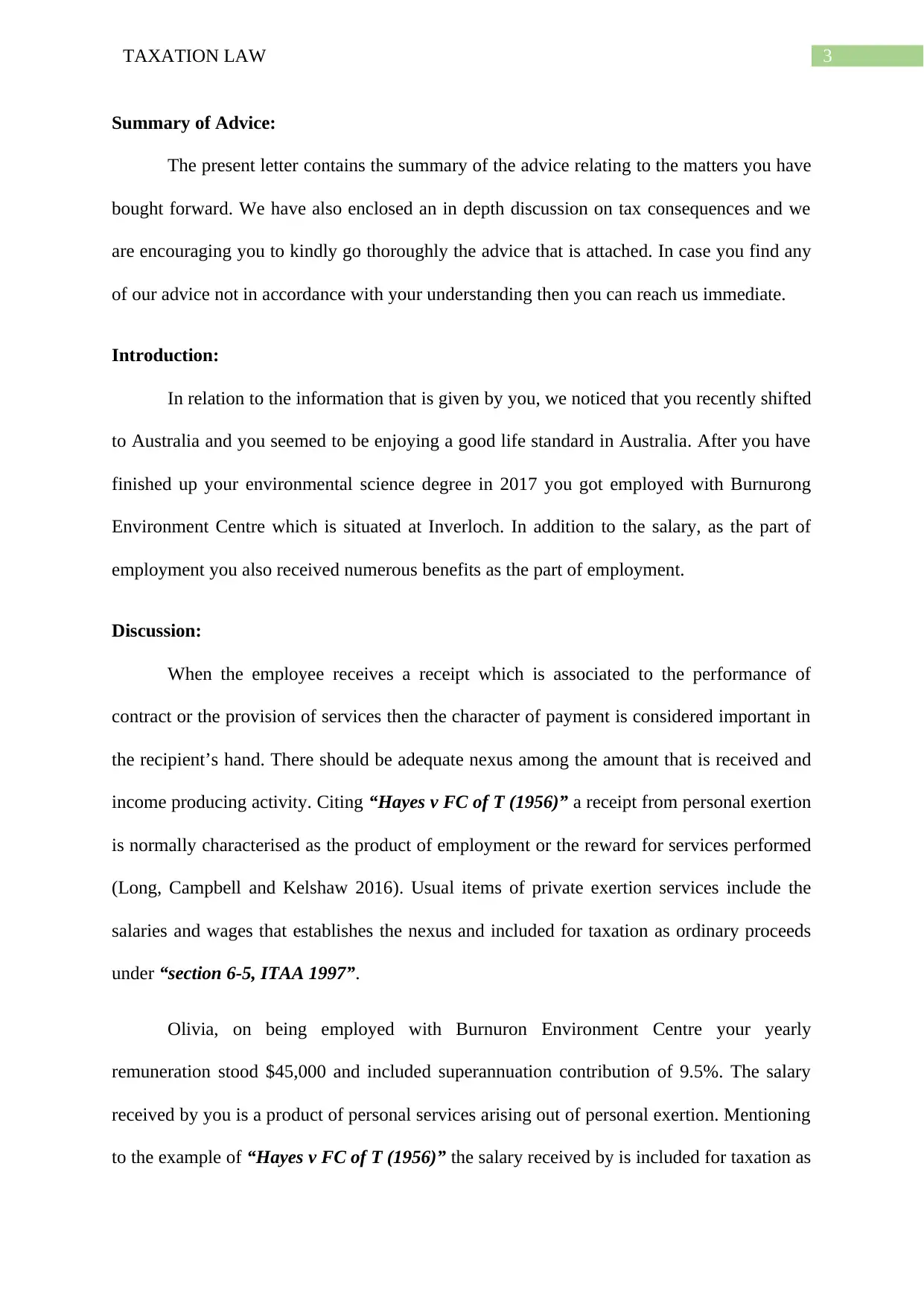
3TAXATION LAW
Summary of Advice:
The present letter contains the summary of the advice relating to the matters you have
bought forward. We have also enclosed an in depth discussion on tax consequences and we
are encouraging you to kindly go thoroughly the advice that is attached. In case you find any
of our advice not in accordance with your understanding then you can reach us immediate.
Introduction:
In relation to the information that is given by you, we noticed that you recently shifted
to Australia and you seemed to be enjoying a good life standard in Australia. After you have
finished up your environmental science degree in 2017 you got employed with Burnurong
Environment Centre which is situated at Inverloch. In addition to the salary, as the part of
employment you also received numerous benefits as the part of employment.
Discussion:
When the employee receives a receipt which is associated to the performance of
contract or the provision of services then the character of payment is considered important in
the recipient’s hand. There should be adequate nexus among the amount that is received and
income producing activity. Citing “Hayes v FC of T (1956)” a receipt from personal exertion
is normally characterised as the product of employment or the reward for services performed
(Long, Campbell and Kelshaw 2016). Usual items of private exertion services include the
salaries and wages that establishes the nexus and included for taxation as ordinary proceeds
under “section 6-5, ITAA 1997”.
Olivia, on being employed with Burnuron Environment Centre your yearly
remuneration stood $45,000 and included superannuation contribution of 9.5%. The salary
received by you is a product of personal services arising out of personal exertion. Mentioning
to the example of “Hayes v FC of T (1956)” the salary received by is included for taxation as
Summary of Advice:
The present letter contains the summary of the advice relating to the matters you have
bought forward. We have also enclosed an in depth discussion on tax consequences and we
are encouraging you to kindly go thoroughly the advice that is attached. In case you find any
of our advice not in accordance with your understanding then you can reach us immediate.
Introduction:
In relation to the information that is given by you, we noticed that you recently shifted
to Australia and you seemed to be enjoying a good life standard in Australia. After you have
finished up your environmental science degree in 2017 you got employed with Burnurong
Environment Centre which is situated at Inverloch. In addition to the salary, as the part of
employment you also received numerous benefits as the part of employment.
Discussion:
When the employee receives a receipt which is associated to the performance of
contract or the provision of services then the character of payment is considered important in
the recipient’s hand. There should be adequate nexus among the amount that is received and
income producing activity. Citing “Hayes v FC of T (1956)” a receipt from personal exertion
is normally characterised as the product of employment or the reward for services performed
(Long, Campbell and Kelshaw 2016). Usual items of private exertion services include the
salaries and wages that establishes the nexus and included for taxation as ordinary proceeds
under “section 6-5, ITAA 1997”.
Olivia, on being employed with Burnuron Environment Centre your yearly
remuneration stood $45,000 and included superannuation contribution of 9.5%. The salary
received by you is a product of personal services arising out of personal exertion. Mentioning
to the example of “Hayes v FC of T (1956)” the salary received by is included for taxation as
Paraphrase This Document
Need a fresh take? Get an instant paraphrase of this document with our AI Paraphraser
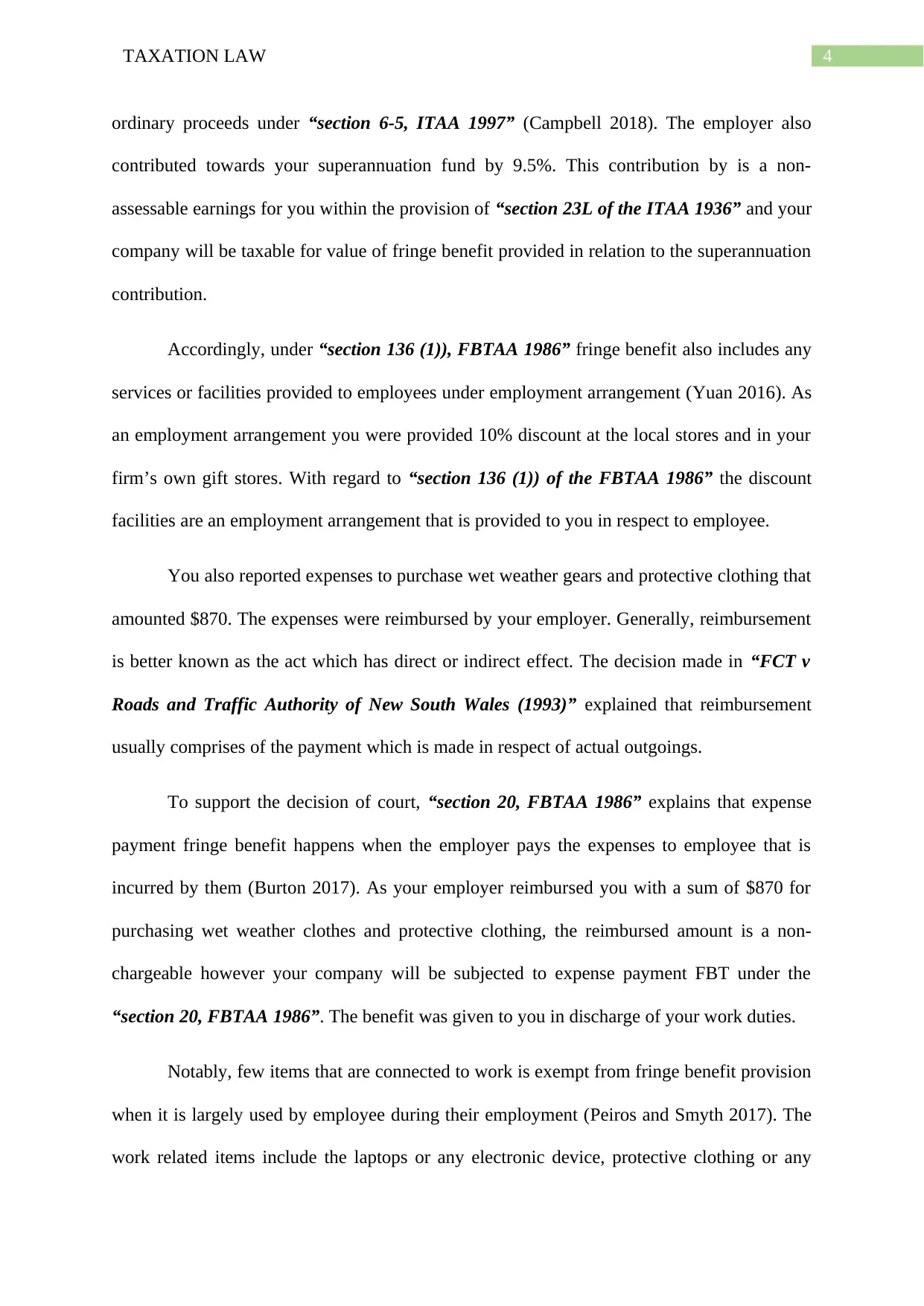
4TAXATION LAW
ordinary proceeds under “section 6-5, ITAA 1997” (Campbell 2018). The employer also
contributed towards your superannuation fund by 9.5%. This contribution by is a non-
assessable earnings for you within the provision of “section 23L of the ITAA 1936” and your
company will be taxable for value of fringe benefit provided in relation to the superannuation
contribution.
Accordingly, under “section 136 (1)), FBTAA 1986” fringe benefit also includes any
services or facilities provided to employees under employment arrangement (Yuan 2016). As
an employment arrangement you were provided 10% discount at the local stores and in your
firm’s own gift stores. With regard to “section 136 (1)) of the FBTAA 1986” the discount
facilities are an employment arrangement that is provided to you in respect to employee.
You also reported expenses to purchase wet weather gears and protective clothing that
amounted $870. The expenses were reimbursed by your employer. Generally, reimbursement
is better known as the act which has direct or indirect effect. The decision made in “FCT v
Roads and Traffic Authority of New South Wales (1993)” explained that reimbursement
usually comprises of the payment which is made in respect of actual outgoings.
To support the decision of court, “section 20, FBTAA 1986” explains that expense
payment fringe benefit happens when the employer pays the expenses to employee that is
incurred by them (Burton 2017). As your employer reimbursed you with a sum of $870 for
purchasing wet weather clothes and protective clothing, the reimbursed amount is a non-
chargeable however your company will be subjected to expense payment FBT under the
“section 20, FBTAA 1986”. The benefit was given to you in discharge of your work duties.
Notably, few items that are connected to work is exempt from fringe benefit provision
when it is largely used by employee during their employment (Peiros and Smyth 2017). The
work related items include the laptops or any electronic device, protective clothing or any
ordinary proceeds under “section 6-5, ITAA 1997” (Campbell 2018). The employer also
contributed towards your superannuation fund by 9.5%. This contribution by is a non-
assessable earnings for you within the provision of “section 23L of the ITAA 1936” and your
company will be taxable for value of fringe benefit provided in relation to the superannuation
contribution.
Accordingly, under “section 136 (1)), FBTAA 1986” fringe benefit also includes any
services or facilities provided to employees under employment arrangement (Yuan 2016). As
an employment arrangement you were provided 10% discount at the local stores and in your
firm’s own gift stores. With regard to “section 136 (1)) of the FBTAA 1986” the discount
facilities are an employment arrangement that is provided to you in respect to employee.
You also reported expenses to purchase wet weather gears and protective clothing that
amounted $870. The expenses were reimbursed by your employer. Generally, reimbursement
is better known as the act which has direct or indirect effect. The decision made in “FCT v
Roads and Traffic Authority of New South Wales (1993)” explained that reimbursement
usually comprises of the payment which is made in respect of actual outgoings.
To support the decision of court, “section 20, FBTAA 1986” explains that expense
payment fringe benefit happens when the employer pays the expenses to employee that is
incurred by them (Burton 2017). As your employer reimbursed you with a sum of $870 for
purchasing wet weather clothes and protective clothing, the reimbursed amount is a non-
chargeable however your company will be subjected to expense payment FBT under the
“section 20, FBTAA 1986”. The benefit was given to you in discharge of your work duties.
Notably, few items that are connected to work is exempt from fringe benefit provision
when it is largely used by employee during their employment (Peiros and Smyth 2017). The
work related items include the laptops or any electronic device, protective clothing or any
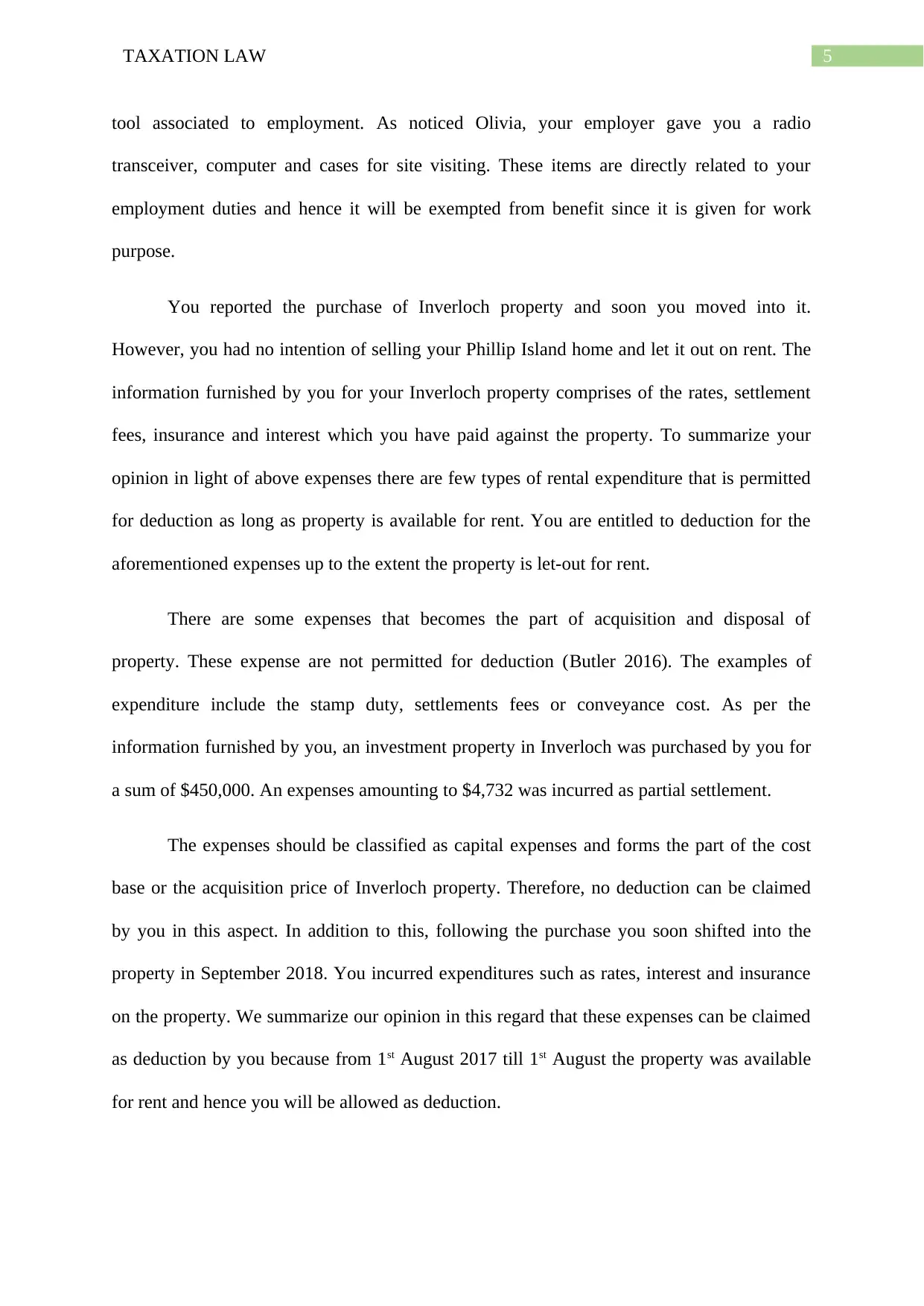
5TAXATION LAW
tool associated to employment. As noticed Olivia, your employer gave you a radio
transceiver, computer and cases for site visiting. These items are directly related to your
employment duties and hence it will be exempted from benefit since it is given for work
purpose.
You reported the purchase of Inverloch property and soon you moved into it.
However, you had no intention of selling your Phillip Island home and let it out on rent. The
information furnished by you for your Inverloch property comprises of the rates, settlement
fees, insurance and interest which you have paid against the property. To summarize your
opinion in light of above expenses there are few types of rental expenditure that is permitted
for deduction as long as property is available for rent. You are entitled to deduction for the
aforementioned expenses up to the extent the property is let-out for rent.
There are some expenses that becomes the part of acquisition and disposal of
property. These expense are not permitted for deduction (Butler 2016). The examples of
expenditure include the stamp duty, settlements fees or conveyance cost. As per the
information furnished by you, an investment property in Inverloch was purchased by you for
a sum of $450,000. An expenses amounting to $4,732 was incurred as partial settlement.
The expenses should be classified as capital expenses and forms the part of the cost
base or the acquisition price of Inverloch property. Therefore, no deduction can be claimed
by you in this aspect. In addition to this, following the purchase you soon shifted into the
property in September 2018. You incurred expenditures such as rates, interest and insurance
on the property. We summarize our opinion in this regard that these expenses can be claimed
as deduction by you because from 1st August 2017 till 1st August the property was available
for rent and hence you will be allowed as deduction.
tool associated to employment. As noticed Olivia, your employer gave you a radio
transceiver, computer and cases for site visiting. These items are directly related to your
employment duties and hence it will be exempted from benefit since it is given for work
purpose.
You reported the purchase of Inverloch property and soon you moved into it.
However, you had no intention of selling your Phillip Island home and let it out on rent. The
information furnished by you for your Inverloch property comprises of the rates, settlement
fees, insurance and interest which you have paid against the property. To summarize your
opinion in light of above expenses there are few types of rental expenditure that is permitted
for deduction as long as property is available for rent. You are entitled to deduction for the
aforementioned expenses up to the extent the property is let-out for rent.
There are some expenses that becomes the part of acquisition and disposal of
property. These expense are not permitted for deduction (Butler 2016). The examples of
expenditure include the stamp duty, settlements fees or conveyance cost. As per the
information furnished by you, an investment property in Inverloch was purchased by you for
a sum of $450,000. An expenses amounting to $4,732 was incurred as partial settlement.
The expenses should be classified as capital expenses and forms the part of the cost
base or the acquisition price of Inverloch property. Therefore, no deduction can be claimed
by you in this aspect. In addition to this, following the purchase you soon shifted into the
property in September 2018. You incurred expenditures such as rates, interest and insurance
on the property. We summarize our opinion in this regard that these expenses can be claimed
as deduction by you because from 1st August 2017 till 1st August the property was available
for rent and hence you will be allowed as deduction.
⊘ This is a preview!⊘
Do you want full access?
Subscribe today to unlock all pages.

Trusted by 1+ million students worldwide
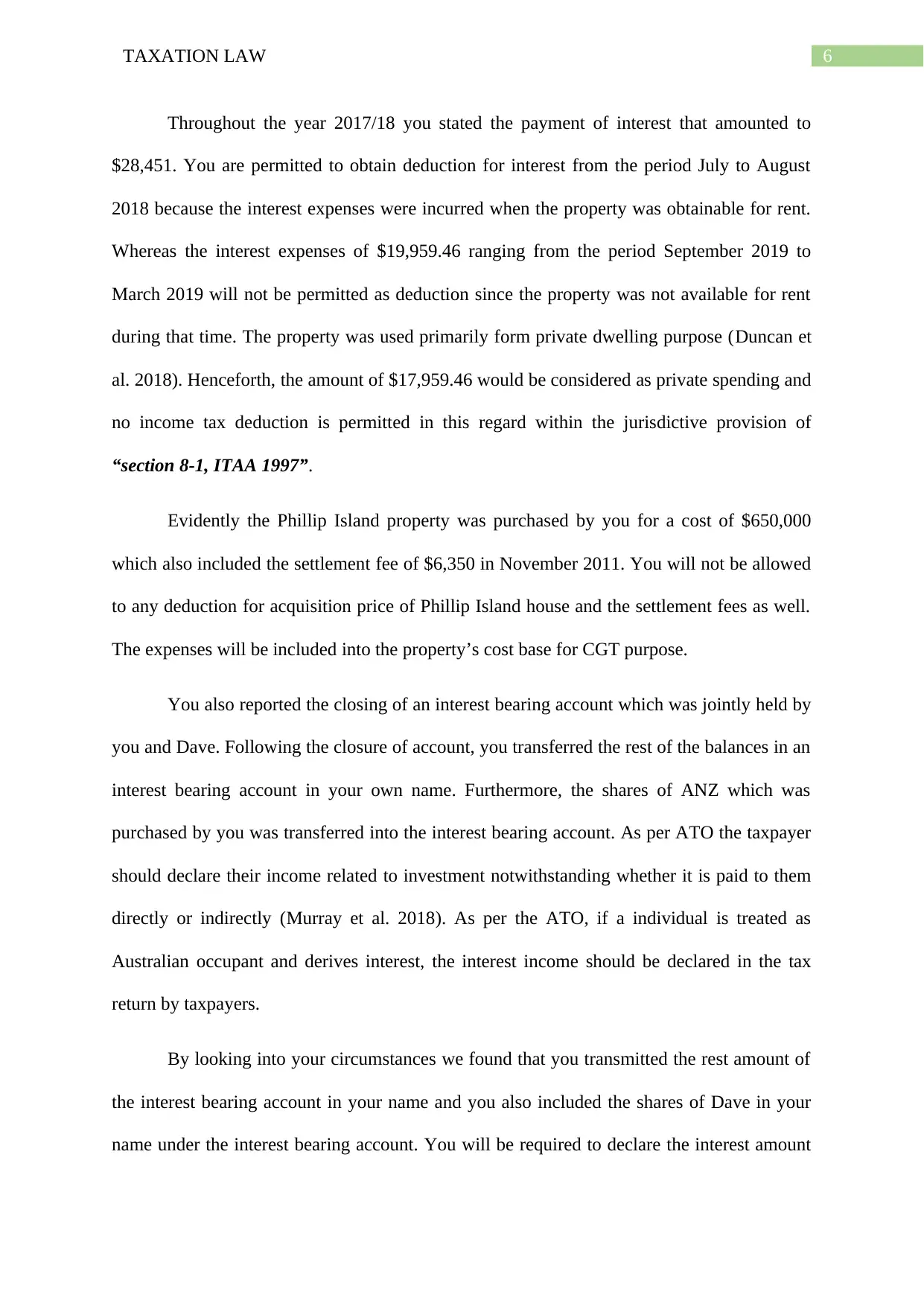
6TAXATION LAW
Throughout the year 2017/18 you stated the payment of interest that amounted to
$28,451. You are permitted to obtain deduction for interest from the period July to August
2018 because the interest expenses were incurred when the property was obtainable for rent.
Whereas the interest expenses of $19,959.46 ranging from the period September 2019 to
March 2019 will not be permitted as deduction since the property was not available for rent
during that time. The property was used primarily form private dwelling purpose (Duncan et
al. 2018). Henceforth, the amount of $17,959.46 would be considered as private spending and
no income tax deduction is permitted in this regard within the jurisdictive provision of
“section 8-1, ITAA 1997”.
Evidently the Phillip Island property was purchased by you for a cost of $650,000
which also included the settlement fee of $6,350 in November 2011. You will not be allowed
to any deduction for acquisition price of Phillip Island house and the settlement fees as well.
The expenses will be included into the property’s cost base for CGT purpose.
You also reported the closing of an interest bearing account which was jointly held by
you and Dave. Following the closure of account, you transferred the rest of the balances in an
interest bearing account in your own name. Furthermore, the shares of ANZ which was
purchased by you was transferred into the interest bearing account. As per ATO the taxpayer
should declare their income related to investment notwithstanding whether it is paid to them
directly or indirectly (Murray et al. 2018). As per the ATO, if a individual is treated as
Australian occupant and derives interest, the interest income should be declared in the tax
return by taxpayers.
By looking into your circumstances we found that you transmitted the rest amount of
the interest bearing account in your name and you also included the shares of Dave in your
name under the interest bearing account. You will be required to declare the interest amount
Throughout the year 2017/18 you stated the payment of interest that amounted to
$28,451. You are permitted to obtain deduction for interest from the period July to August
2018 because the interest expenses were incurred when the property was obtainable for rent.
Whereas the interest expenses of $19,959.46 ranging from the period September 2019 to
March 2019 will not be permitted as deduction since the property was not available for rent
during that time. The property was used primarily form private dwelling purpose (Duncan et
al. 2018). Henceforth, the amount of $17,959.46 would be considered as private spending and
no income tax deduction is permitted in this regard within the jurisdictive provision of
“section 8-1, ITAA 1997”.
Evidently the Phillip Island property was purchased by you for a cost of $650,000
which also included the settlement fee of $6,350 in November 2011. You will not be allowed
to any deduction for acquisition price of Phillip Island house and the settlement fees as well.
The expenses will be included into the property’s cost base for CGT purpose.
You also reported the closing of an interest bearing account which was jointly held by
you and Dave. Following the closure of account, you transferred the rest of the balances in an
interest bearing account in your own name. Furthermore, the shares of ANZ which was
purchased by you was transferred into the interest bearing account. As per ATO the taxpayer
should declare their income related to investment notwithstanding whether it is paid to them
directly or indirectly (Murray et al. 2018). As per the ATO, if a individual is treated as
Australian occupant and derives interest, the interest income should be declared in the tax
return by taxpayers.
By looking into your circumstances we found that you transmitted the rest amount of
the interest bearing account in your name and you also included the shares of Dave in your
name under the interest bearing account. You will be required to declare the interest amount
Paraphrase This Document
Need a fresh take? Get an instant paraphrase of this document with our AI Paraphraser
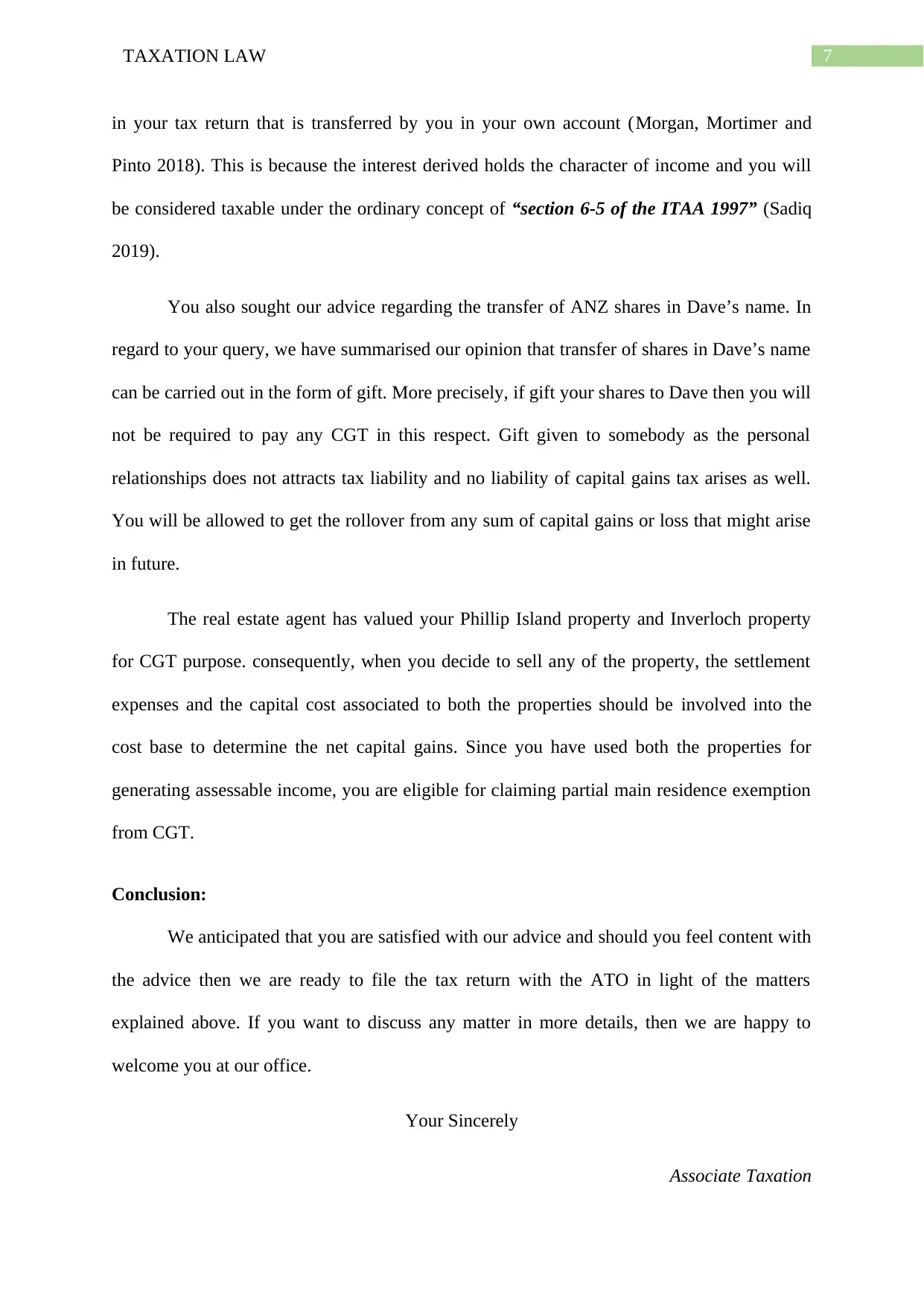
7TAXATION LAW
in your tax return that is transferred by you in your own account (Morgan, Mortimer and
Pinto 2018). This is because the interest derived holds the character of income and you will
be considered taxable under the ordinary concept of “section 6-5 of the ITAA 1997” (Sadiq
2019).
You also sought our advice regarding the transfer of ANZ shares in Dave’s name. In
regard to your query, we have summarised our opinion that transfer of shares in Dave’s name
can be carried out in the form of gift. More precisely, if gift your shares to Dave then you will
not be required to pay any CGT in this respect. Gift given to somebody as the personal
relationships does not attracts tax liability and no liability of capital gains tax arises as well.
You will be allowed to get the rollover from any sum of capital gains or loss that might arise
in future.
The real estate agent has valued your Phillip Island property and Inverloch property
for CGT purpose. consequently, when you decide to sell any of the property, the settlement
expenses and the capital cost associated to both the properties should be involved into the
cost base to determine the net capital gains. Since you have used both the properties for
generating assessable income, you are eligible for claiming partial main residence exemption
from CGT.
Conclusion:
We anticipated that you are satisfied with our advice and should you feel content with
the advice then we are ready to file the tax return with the ATO in light of the matters
explained above. If you want to discuss any matter in more details, then we are happy to
welcome you at our office.
Your Sincerely
Associate Taxation
in your tax return that is transferred by you in your own account (Morgan, Mortimer and
Pinto 2018). This is because the interest derived holds the character of income and you will
be considered taxable under the ordinary concept of “section 6-5 of the ITAA 1997” (Sadiq
2019).
You also sought our advice regarding the transfer of ANZ shares in Dave’s name. In
regard to your query, we have summarised our opinion that transfer of shares in Dave’s name
can be carried out in the form of gift. More precisely, if gift your shares to Dave then you will
not be required to pay any CGT in this respect. Gift given to somebody as the personal
relationships does not attracts tax liability and no liability of capital gains tax arises as well.
You will be allowed to get the rollover from any sum of capital gains or loss that might arise
in future.
The real estate agent has valued your Phillip Island property and Inverloch property
for CGT purpose. consequently, when you decide to sell any of the property, the settlement
expenses and the capital cost associated to both the properties should be involved into the
cost base to determine the net capital gains. Since you have used both the properties for
generating assessable income, you are eligible for claiming partial main residence exemption
from CGT.
Conclusion:
We anticipated that you are satisfied with our advice and should you feel content with
the advice then we are ready to file the tax return with the ATO in light of the matters
explained above. If you want to discuss any matter in more details, then we are happy to
welcome you at our office.
Your Sincerely
Associate Taxation

8TAXATION LAW
Pitchers Tax Consultants
Pitchers Tax Consultants
⊘ This is a preview!⊘
Do you want full access?
Subscribe today to unlock all pages.

Trusted by 1+ million students worldwide
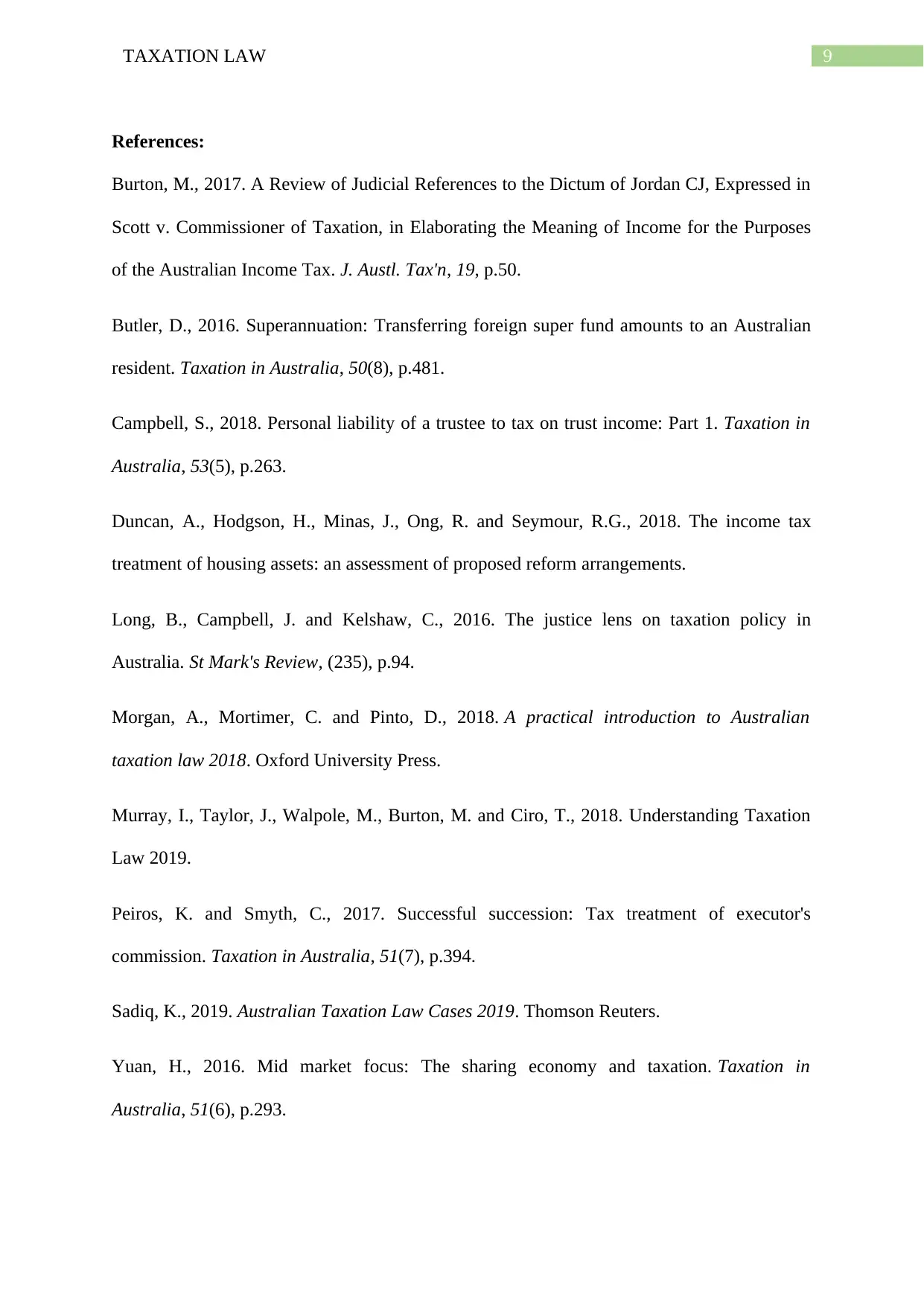
9TAXATION LAW
References:
Burton, M., 2017. A Review of Judicial References to the Dictum of Jordan CJ, Expressed in
Scott v. Commissioner of Taxation, in Elaborating the Meaning of Income for the Purposes
of the Australian Income Tax. J. Austl. Tax'n, 19, p.50.
Butler, D., 2016. Superannuation: Transferring foreign super fund amounts to an Australian
resident. Taxation in Australia, 50(8), p.481.
Campbell, S., 2018. Personal liability of a trustee to tax on trust income: Part 1. Taxation in
Australia, 53(5), p.263.
Duncan, A., Hodgson, H., Minas, J., Ong, R. and Seymour, R.G., 2018. The income tax
treatment of housing assets: an assessment of proposed reform arrangements.
Long, B., Campbell, J. and Kelshaw, C., 2016. The justice lens on taxation policy in
Australia. St Mark's Review, (235), p.94.
Morgan, A., Mortimer, C. and Pinto, D., 2018. A practical introduction to Australian
taxation law 2018. Oxford University Press.
Murray, I., Taylor, J., Walpole, M., Burton, M. and Ciro, T., 2018. Understanding Taxation
Law 2019.
Peiros, K. and Smyth, C., 2017. Successful succession: Tax treatment of executor's
commission. Taxation in Australia, 51(7), p.394.
Sadiq, K., 2019. Australian Taxation Law Cases 2019. Thomson Reuters.
Yuan, H., 2016. Mid market focus: The sharing economy and taxation. Taxation in
Australia, 51(6), p.293.
References:
Burton, M., 2017. A Review of Judicial References to the Dictum of Jordan CJ, Expressed in
Scott v. Commissioner of Taxation, in Elaborating the Meaning of Income for the Purposes
of the Australian Income Tax. J. Austl. Tax'n, 19, p.50.
Butler, D., 2016. Superannuation: Transferring foreign super fund amounts to an Australian
resident. Taxation in Australia, 50(8), p.481.
Campbell, S., 2018. Personal liability of a trustee to tax on trust income: Part 1. Taxation in
Australia, 53(5), p.263.
Duncan, A., Hodgson, H., Minas, J., Ong, R. and Seymour, R.G., 2018. The income tax
treatment of housing assets: an assessment of proposed reform arrangements.
Long, B., Campbell, J. and Kelshaw, C., 2016. The justice lens on taxation policy in
Australia. St Mark's Review, (235), p.94.
Morgan, A., Mortimer, C. and Pinto, D., 2018. A practical introduction to Australian
taxation law 2018. Oxford University Press.
Murray, I., Taylor, J., Walpole, M., Burton, M. and Ciro, T., 2018. Understanding Taxation
Law 2019.
Peiros, K. and Smyth, C., 2017. Successful succession: Tax treatment of executor's
commission. Taxation in Australia, 51(7), p.394.
Sadiq, K., 2019. Australian Taxation Law Cases 2019. Thomson Reuters.
Yuan, H., 2016. Mid market focus: The sharing economy and taxation. Taxation in
Australia, 51(6), p.293.
Paraphrase This Document
Need a fresh take? Get an instant paraphrase of this document with our AI Paraphraser

10TAXATION LAW
1 out of 11
Related Documents
Your All-in-One AI-Powered Toolkit for Academic Success.
+13062052269
info@desklib.com
Available 24*7 on WhatsApp / Email
![[object Object]](/_next/static/media/star-bottom.7253800d.svg)
Unlock your academic potential
Copyright © 2020–2025 A2Z Services. All Rights Reserved. Developed and managed by ZUCOL.





